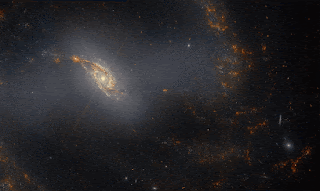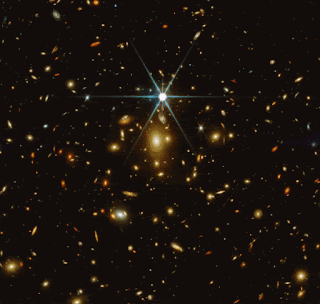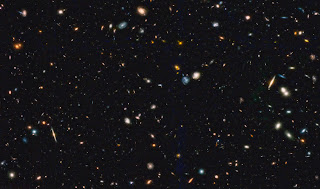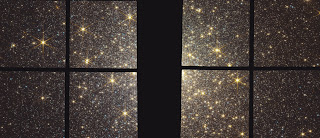 |
| Credit: NASA, ESA, CSA, STScI |
JWST Log
(Scrapbooking JWST)
Friday, November 18, 2022
Tuesday, October 25, 2022
M16 (NGC 6611) - Pillars of Creation
 |
| Credit: NASA, ESA, CSA, STScI |
 |
| Credit: NASA, ESA, CSA, STScI (Hubble and Webb Slide Tool) |
 |
| Credit: NASA, ESA, CSA, STScI (MIRI and NIRCam Slider Tool) |
 |
| Credit: NASA, ESA, CSA, STScI, Ant_H. |
 |
| Credit: NASA, ESA, CSA, STScI, u/DatSexyFoxx |
 |
| Credit: Space Telescope Science Institute |
 |
| Credit: Grant Tremblay |
 |
| Credit: Mark McCaughrean |
| Credit: AAS WorldWide Telescope Pillars of Creation |
Wednesday, October 12, 2022
Circumstellar Disk Orion 294-606
 |
 |
| Credit: JWST NIRCam F187N filter (Paschen-a), McCaughrean & Pearson |
"Hello darkness, my old friend"
— Mark McCaughrean (@markmccaughrean) October 7, 2022
A tiny snippet from our new #JWST data, showing a planetary system in the making, floating in space & silhouetted against the bright background light of the Orion Nebula.
1/ pic.twitter.com/bvMvLsfJq1
Tuesday, October 11, 2022
VV 191 Galaxy Pair
 |
| Credit: NASA, ESA, CSA, STScI, R. Windhorst (Arizona State University), W. Keel (University of Alabama), S. Wyithe (University of Melbourne, Australia), and the JWST PEARLS Team |
Monday, October 10, 2022
Thursday, September 22, 2022
Neptune
.jpg) |
| Credit: NASA, ESA, CSA, and STScI |
 |
| Credit: NASA, ESA, CSA, and STScI |
.tif) |
| Credit: NASA, ESA, CSA, and STScI |
.jpg) |
| Credit: Voyager: NASA/JPL-Caltech, Hubble: NASA, ESA, A. Simon (Goddard Space Flight Center), and M.H. Wong (University of California, Berkeley) and the OPAL team, Webb: NASA, ESA, CSA, STScI |
.jpeg) |
| Credit: NASA, ESA, CSA, STScI and Dr Heidi B. Hammel |
In the late 1990s, I was a young scientist at MIT, finishing up my Voyager 2 Neptune analysis grant. I also had just used the amazing Hubble to discover that Neptune's Great Dark Spot, discovered by Voyager 2 in 1989 (see picture), had disappeared! See https://t.co/l3CYH9VGaH pic.twitter.com/rIYNEILkIq
— Dr Heidi B. Hammel (@hbhammel) September 22, 2022
Wednesday, September 7, 2022
NGC 2070, 30 Doradus, RMC 136, Tarantula Nebula, Caldwell 103
 |
| Credit: NASA, ESA, CSA, STScI, Webb ERO Production Team |
 |
| Credit: NASA, ESA, CSA, STScI, Roberto Colombari |
 |
| Credit: NASA, ESA, CSA, STScI, Tom Williams |
Tuesday, August 16, 2022
NGC 1365 - Barred Spiral Galaxy
 |
| Credit: NASA, ESA, CSA, STScI, Judy Schmidt |
 |
| Credit: NASA, ESA, CSA, STScI, Judy Schmidt |
 |
| Credit: NASA, ESA, CSA, STScI, sairjohn |
 |
| Credit: NASA, ESA, CSA, STScI, Desolatora |
 |
| Credit: NASA, ESA, CSA, STScI, Judy Schmidt |
Friday, August 12, 2022
Thursday, August 11, 2022
WHL0137-LS - Earendel (Star) Lensed By Galaxy Cluster WHL0137-08
 |
 |
| Galaxies brighten and appear as the Hubble image fades into the JWST image of the WHL0137-08 galaxy cluster. |
 |
| Credit: NASA, ESA, CSA, STScI, Cosmic Spring JWST |
Thursday, August 4, 2022
CEERS Collaboration Wide/Deep Field Mosaic
 |
| Credit: NASA, ESA, CSA, STScI, CEERS |
 |
| Credit: NASA, ESA, CSA, STScI, CEERS |
 |
| Credit: NASA, ESA, CSA, STScI, CEERS |
The hits from #JWST keep on coming — here's a new deep galaxy map from the CEERS collaboration! #UnfoldTheUniversehttps://t.co/Zq11gNaHf1
— AAS WorldWide Telescope (@WWTelescope) August 8, 2022
I have been waiting so long to share this, and it is finally time! Do you want to see THE BIGGEST IMAGE #JWST has taken of galaxies so far?! Our color mosaic image from @ceers_jwst is ready, and there are SO MANY GALAXIES in it! Download it here & ZOOM IN https://t.co/DJcBu8DMFl pic.twitter.com/7mhRntpXOY
— Rebecca Larson (@SaturnsWings) August 16, 2022


